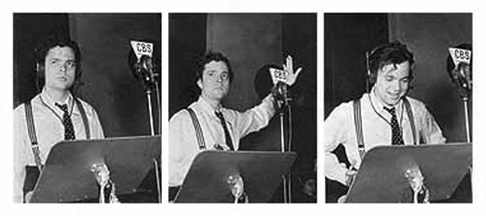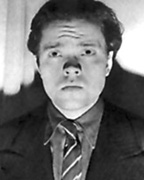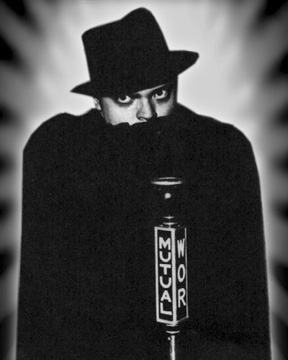Orson Welles: A Film Maker With A "Sound" Background.

An extended essay about OTR's influence on Welles, and eventually, Film
By Kurt Kuersteiner © 2000
.
Orson Welles is remembered in movie circles as the creator of "Citizen Kane", one of the greatest movies ever made. But it was Orson Welles very first film. How did a novice movie maker manage to pull off something so spectacular and original? How could he take such a risk with his premier film, and like a gifted poker player, not only beat the odds but spawn so many imitators? I submit that it was because of the experimentation and innovation he experienced in a related field, radio. Radio allowed Welles to attempt many of his story telling techniques in a more demanding atmosphere (sound only). This made Welles familiar with many subtleties other movie makers had overlooked, creative effects and transitions that would later become common place in movie making, but were new to the cinema when Welles introduced them.
Some critics say Welles was a great movie maker because he was never taught how to make movies. He didn't know the rules of film making, so it was easy for him to break them. But I would twist that notion around a bit: Welles knew all the rules by heart, only they were the wrong rules- the rules of radio instead of film. This, I believe, is what gave Welles his unique style that seemed so fresh at the time. This opinion is reinforced by the fact that as time went on and Welles left radio, his work emphasized sound less and less, and became more and more visual.
To "see" the origin of this visual audio style, one most go back before his movies and examine Welles' earlier radio work. There are dozens of them, so I will only focus on the ones which had elements which could, and often did, resurface in later films. The first is "The Shadow", the famous radio series about the invisible crusader that could "cloud men's minds so that they can not see them". Although Welles wrote none of the stories, he played the lead, and as such, routinely demonstrated the rules of radio "imaging". This included the use of distorted sound to convey where the characters were, even though no set could be seen. Other routine techniques were adding echoes to imply empty halls, fading the sound to suggest increasing distance, and using filters to convey the thoughts of an individual from within their skull (as heard on "The Shadow"). While Hollywood was striving for clearest, cleanest sound, radio was showing Welles how-- and more importantly, why-- to distort the soundtrack.
But radio inspired more than new ways to distort the dialogue and make the ambient sound more realistic. It also helped Welles with new approaches in montages through sound, like in his Mercury Theater Production of "Dracula". In that broadcast, Harker and Van Helsing race across country to reach Mina before Dracula wakes at Sundown. A montage of sound is created between the beat of the train, Mina's trance like murmuring, and the frantic blows of the train whistle. No doubt a film version could have been presented exactly the same way, but with little improvement to the exciting building of rhythm, sound, and tension. The broadcast is also one of many in which another layer of meaning is made with sound effects. Contrasts between Dracula and the animals outside his castle are constantly made via background sound effects. This is a theme Welles will use again later in film, even to the point of not showing the animal, but only hearing it.
Perhaps the most famous of the Welles radio productions is the 1938 "War of the Worlds" production. At first consideration, one might think it difficult to adapt much from a news style radio broadcast to film. But it is precisely the "style" that Welles used in later films so effectively, because it was a deliberate use of errors that made "War of the Worlds" so believable. Unlike standard news casts, "War of the Worlds" had dead air, intentional mistakes in dialogue, and chaotic and confusing moments deliberately woven into the script. This gave it the "unrehearsed" feeling that made millions of Americans believe it was real, not scripted. Particularly eerie is the portion in which the news man in the field is describing how the heat ray is pointing at him, and then his line goes dead. A long silence follows. Then a studio newscaster comes on and cheerfully apologizes for some "technical difficulties that will be cleared up shortly" and then plays some soothing piano music. Its like having the pilot insist nothing is the matter on the intercom after a loud thump. Why are they trying so hard to convince us unless they're lying? They may not be aware of the danger, but we are.
"Rebecca" is another radio drama that introduces another subtle device that Welles will take delight in using later in film. The unexplained noise that will be explained only after we become curious what it is. In "Rebecca", it is the sound of distant explosions. Even the main character can't explain it at first, but she later discovers (as we do) that it is the sound of rocket flairs being shot by a sinking ship.
"The Magnificent Ambersons" is just one of several radio dramas Welles later made into film. In fact, it was to be his first film (after "Heart of Darkness" and "The Smiler with the Knife" were passed over). This rendition shows what Welles would have been like as George Minafer had he played the part in the movie. More importantly, it uses the same Bernard Herman score that is used years later in the film. Indeed, Welles use of Bernard Herman and his music is consistent throughout his radio work, and did a lot to promote both artists careers. Welles even played portions of the program on the sound stage to have the same film actors "lip synch" speeches. The intent being that they would retain the exact pattern, meter and feeling they had when they focused on their voice performances alone.

When Welles finally did get his break to apply these techniques to film, he didn't blow it. "Citizen Kane" pulls all the stops. The "Hollywood on the March" sequence pays tribute to earlier techniques adapted from "War of the Worlds". Kane is shown through the fence with a jittery hand held camera, much like the man with the portable microphone struggling to get a decent sound bite from the the Martian spaceship. Indeed, when Kane speaks to a reporter, he is prodded into speaking closer to the microphone. These are realistic touches that make us take for granted what we are seeing and hearing are real people, not professional actors. Of course, like the man on a soap box publicly calling Kane a fascist, his misspoken line is a very carefully rehearsed one.
Not all sound tricks are just to add reality. Many of them also add a deeper meaning. When the reporter goes to Thatcher Library to look up information on Kane, the sound is a very distorted echo. Yes, this adds depth and reality to the scene, but it also reinforces what is already implied on the screen. The Thatcher library is not just a library, it is a tomb. A cold empty tomb to a man who was cold and empty in life as well as death. Likewise, the background yelling of young Kane in the snow adds irony to the bickering of the parents within the warm not-so-happy home. While they sign the papers to have him separated and sent away forever, he is yelling "The Union Forever! Long Live the Union!".
Absence of sound is like the dead air in "War of the Worlds". It emphasizes more than any other sound can. When Kane "stands up" to Thatcher (figuratively and literally) in the newspaper office, the murmur stops and we all stare to see (and hear) Kane declare everything he hates in Thatcher. The entire office is paying full attention to Kane, and so are we. Likewise, the moody music of Bernard Herman adds emphasis to important passages of dialogue and action. Sometimes it's ominous (Q: "What would you have liked to have been?" A: "Everything you hate..." (oboe)). Other times it's comical ("If I keep loosing a million every year, I'll have to shut this newspaper down... in about sixty years." (muted trumpet)).
The mystery sound that is identified later is used as well. When Bernstein remembers Kane, the sound of ticking is heard, later to be shown as a tickertape. It underlines the truth in Bernstein's assertion that it's not hard to make money if that is all one is interested in. After all, he has a tickertape, he should know. One of Bernstein's memories is when Kane came back from Europe. We see/hear one of the first "L" cuts when "Welcome home Mr. Kane" is declared before the image appears. From radio? No, but the tight fluid edit from scene to scene with overlapping dialogue certainly is. And the music themes separate scenes just like they did in Orson's radio days. Like the deep dark blows of ships horns during Jedidiah's testimony (from out in the bay) these sounds aren't accidental atmospheric noises heard through the sound stage walls; They are all placed there deliberately for effect.
Perhaps one of the most famous montage scenes ever made is seen (and heard) in "Citizen Kane". Mary sings and her voice reverberates up through the rafters. The stage hands hear it and pinch their noses. The singing continues and overlaps until the stage light burns out and the music grinds to a halt like an out-of-power record player. This scene is beautiful for its marriage of sight and sound. Like the record running out of power, the light "burns out". Both are excellent analogies of what is happening to Mary.
The symbolism is even greater when the older Kane and Mary are alone in the castle, and cannot hear one another across the room. Of course, they can not hear each other when they are next to each other either, as Kane demonstrates when he slaps her at the picnic while the jazz tone plays "It can't be Love" in the background. We also hear a woman screaming in the background as well, a sound we never trace to its' source, but whatever it is, it has already assumed new meaning in our eyes (and ears).
Sadly, compared to "Citizen Kane", none of Orson Welles films seem to create the same amount of new and exciting uses of sound. But many would say that applies to his visual work as well. "Citizen Kane" was Orson Welles' masterpiece. How many of them is one person expected to produce? And Welles was effectively castrated by the studios after that project anyway (it made no profit), so even if he had it in him, he lacked the resources to execute it.
Yet sound continued to play a important part in Welles' style throughout his career. Besides dialogue from radio projects recorded straight onto the sound tracks of film and lip synched in "Magnificent Ambersons", he did the same technique in "Lady from Shanghai" and "Don Quixote". In "The Stranger", Welles uses sound as a device to let Robinson's character know that the Nazi he seeks has just escaped through a side door. But this is only the cheap version of what Welles had intended to use sound for in that film. Originally, he had wanted to have the Nazi trap Mary in her bedroom, with the sound of caged dogs yelping in the background (remember "Dracula"?). In fact, the entire beginning sequence (cut for costs) used the filtered voice of Welles to speak his thoughts into Mary's head, much like the shadow's voice did years before.
Other examples exist in all of his films, but most of them are repeats of devices he had already used in "Citizen Kane". Like the unknown noise from an unknown origin in "The Trial" (it turns out to be policemen getting whipped for taking bribes), it's just a variation on an earlier theme. But then again, it always is... if you go back far enough. Even the climax of "Touch of Evil"-- when the villain hears the echo of the radio bug and realizes he's been double crossed-- it may seem like a cinematic first, but Welles used it years before in The Shadow episode "The Phantom Voice".

This isn't to say that Welles wasn't creative or original. He was was both. But his genius lay in creating much of what he did in a more experimental medium (radio), realizing what worked best, and reapplying it to broader mediums (film). Even if the idea was not his originally, the new use of it in a different medium was something original in and of itself. Like the man who invented the traffic light, he didn't invent traffic or the light, but he did marry the two in a union that didn't exist before and it worked beautifully as one. This was the special talent of Orson Welles. He saw (and heard) what he liked elsewhere, and brought these elements together where a bigger audience could enjoy it: In his fims.
rev. 11.3.10